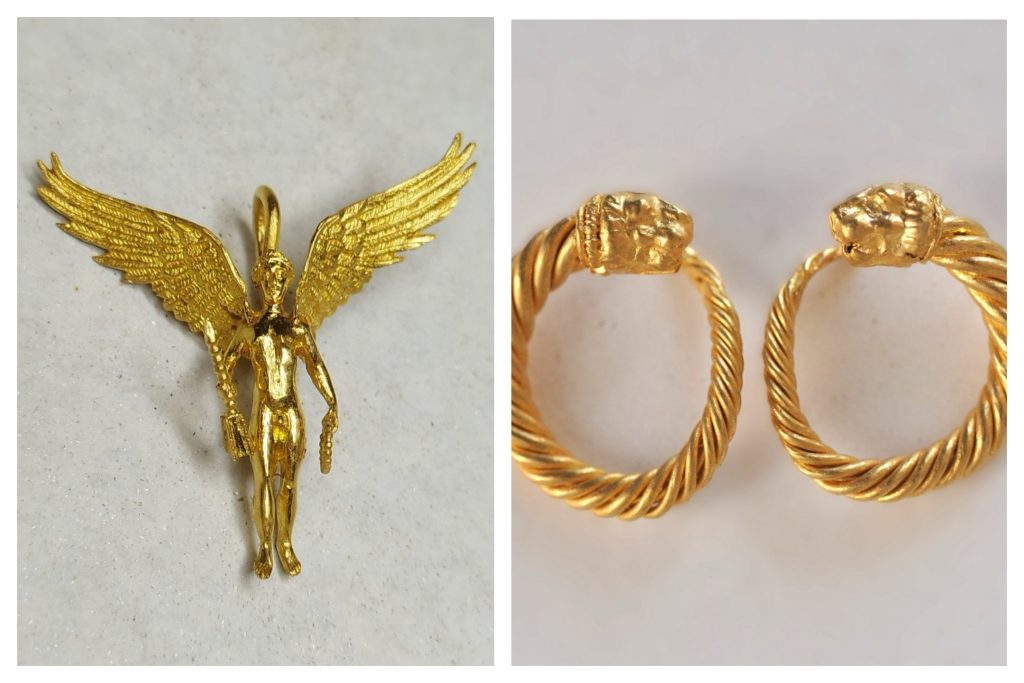An archaeological excavation near Aigio, a town nestled on Greece’s Peloponnese peninsula, has unveiled the remnants of a monumental building believed to be a “heroon”—a shrine dedicated to a revered figure, potentially a hero from Greek mythology or local legend. The discovery offers a fascinating glimpse into the religious and social practices of ancient Greece, shedding light on the customs surrounding hero worship and the artistry of the era. The dig, initiated in early October, concentrated on a structure designated by the Greek letter gamma (“Γ”), preliminarily dated to pre-300 B.C. The excavation revealed substantial architectural elements, including stone blocks, column remnants, and the complete 55-foot kerb outlining the southern side of the building. These finds, alongside other unearthed features, solidify the structure’s identification as a heroon, a type of monument frequently found in ancient Greek cities and sanctuaries.
Heroons served as focal points for venerating heroic figures, often believed to be interred within or associated with the site. These structures varied in complexity, ranging from simple altars or memorials to elaborate edifices housing cult statues and facilitating ritual activities such as sacrifices and annual festivals. The Aigio heroon’s discovery provides valuable insights into the architectural design and purpose of these significant monuments, allowing researchers to delve deeper into the cultural and religious landscape of ancient Greece. The presence of intact burials and a sarcophagus within the heroon further enriches the archaeological narrative. These internments, accompanied by “valuable” offerings of artistic merit, speak volumes about the social status and wealth of the individuals buried within the shrine. The offerings discovered inside the heroon, believed to be from the earlier Hellenistic Period and towards the end of Classical Antiquity (from around the 4th – beginning of the 3rd Century BC) showcase the intricate craftsmanship and artistic sensibilities of the time.
Among the most remarkable artifacts unearthed were a pair of gold earrings adorned with lion heads, a gold earring crafted in the shape of a winged Eros (the Greek god of love, equivalent to the Roman Cupid) holding a scepter and a wreath, and a delicate gold necklace. These exquisite pieces not only highlight the artistic prowess of the period but also provide clues about the beliefs and values of the individuals interred within the heroon. The opulence of the grave goods signifies the high social standing and wealth of those buried within, possibly members of the elite or figures closely associated with the hero being venerated. Eros’ presence among the jewelry finds could point to the hero’s association with love, desire, or perhaps even a connection to a specific mythological narrative. Further analysis of these artifacts will undoubtedly contribute to a deeper understanding of the heroon’s significance and the individuals it commemorated.
The discovery of several lion sculptures carved from Pentelic marble adds another layer of intrigue to the Aigio excavation. Pentelic marble, renowned for its luminous white hue and durability, was a prized material in ancient Greek architecture and sculpture, famously used in the construction of the Parthenon. The presence of these lion sculptures, crafted from this prestigious material, further emphasizes the importance of the heroon and the reverence accorded to its enshrined figure. Lions, often symbolic of strength, courage, and guardianship, may have held a particular significance within the hero cult practiced at the site, potentially representing the hero’s attributes or serving as protectors of the sacred space. The careful selection of Pentelic marble for these sculptures underscores the dedication and resources invested in the heroon’s construction and decoration.
The ongoing investigation of the Aigio heroon promises to yield further insights into the religious and social dynamics of ancient Greece. The discovery of the building itself, along with the rich array of artifacts unearthed within, offers a unique window into the past, allowing researchers to piece together the story of this ancient shrine and the community that revered it. Further analysis of the architectural remains, burial practices, and recovered artifacts will undoubtedly contribute to a more comprehensive understanding of hero worship in ancient Greece and the cultural significance of these monumental structures. The location of the heroon, near the present-day town of Aigio, adds to the expanding archaeological map of the Achaea region, enriching our knowledge of the area’s historical and cultural heritage.
The excavation’s findings contribute significantly to the expanding body of knowledge about ancient Greek religious practices, particularly the customs surrounding hero worship. The Aigio heroon provides a tangible example of the architectural and artistic expressions associated with these cults, allowing researchers to study the physical manifestations of these beliefs. The opulent offerings found within the tombs, combined with the use of Pentelic marble for the lion sculptures, showcase the wealth and importance attributed to the hero and the associated rituals. Furthermore, the discovery sheds light on the social hierarchy of the time, suggesting the presence of an elite class capable of commissioning elaborate structures and procuring precious materials. As researchers continue to analyze the artifacts and architectural remains, the Aigio heroon promises to reveal further secrets of ancient Greece, deepening our understanding of its rich cultural tapestry and the enduring legacy of its heroes.










